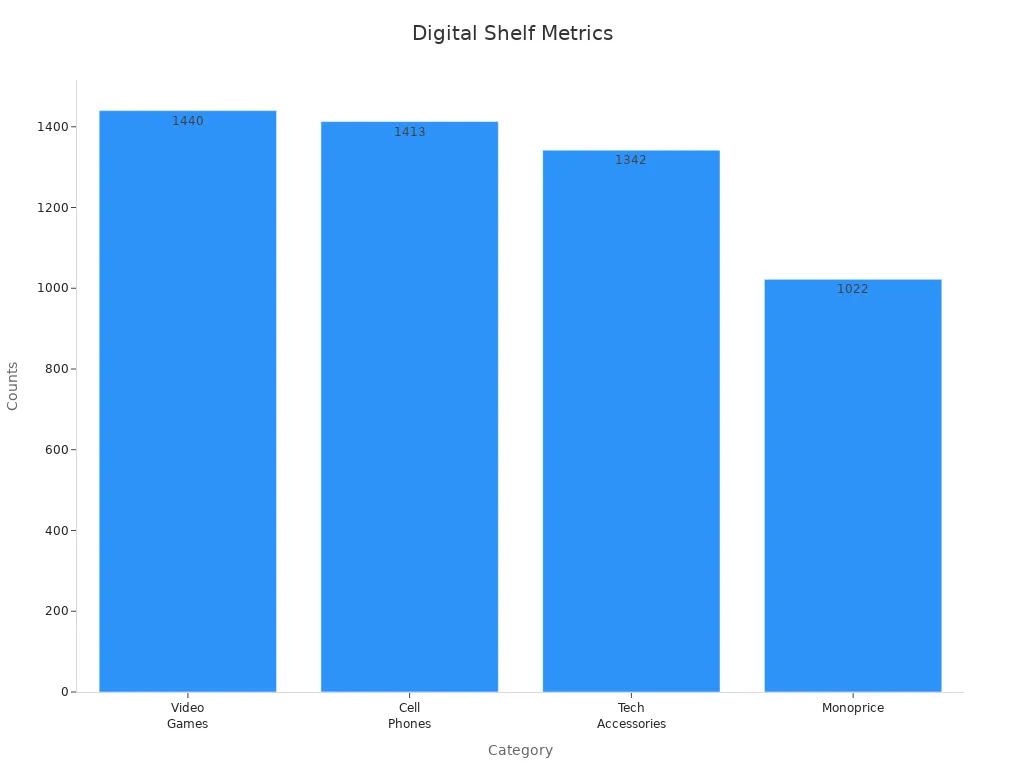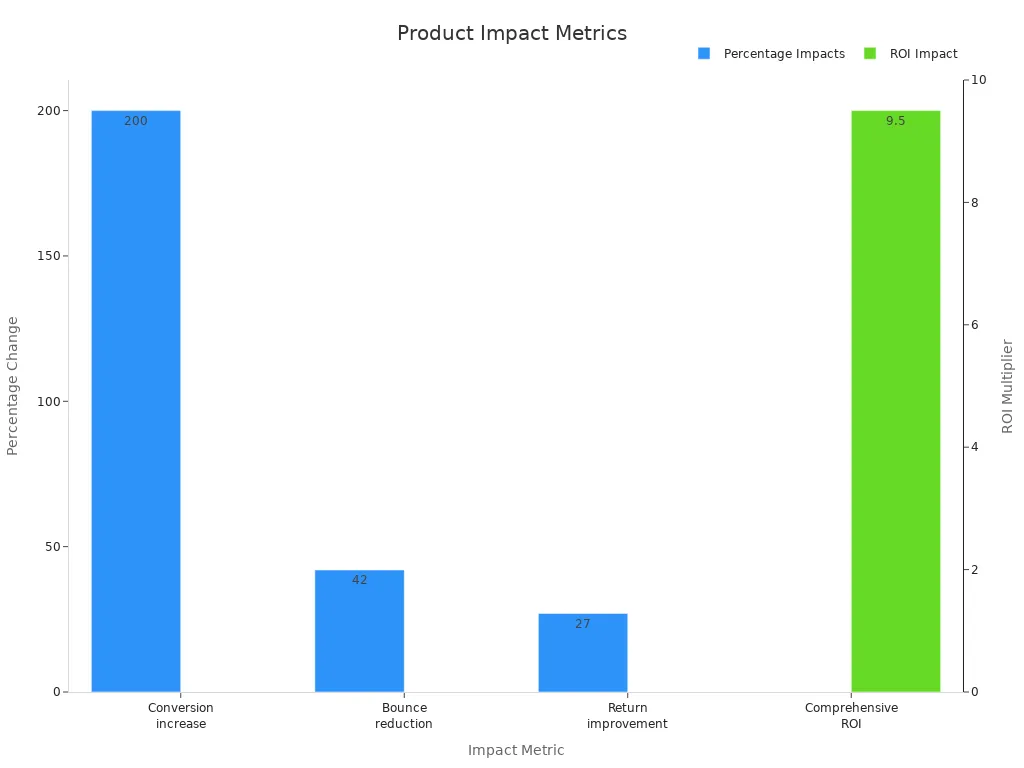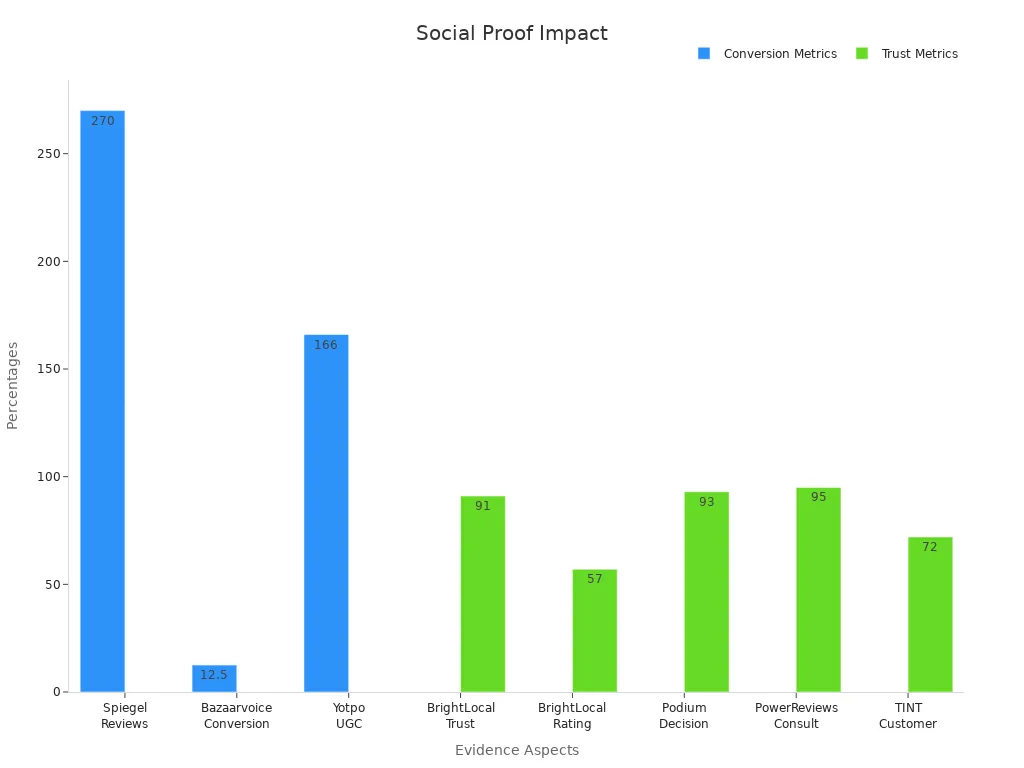
Digital shelf optimization shapes your online store’s success by improving product visibility and conversion rates. When you use Electronic Shelf Labels or an ESL Gateway AP, you streamline pricing and inventory updates, making Esl Retail operations more efficient. The US consumer electronics market, with $159.9 billion in projected revenue, shows the impact of precise optimization.
| Metric/Category | Numerical Data/Statistic |
|---|---|
| US Consumer Electronics Market Revenue | $159.9 billion (2024 forecast) |
| Percentage of Revenue from Online Sales | 50% |
| Number of Products Analyzed at Target | 16,385 products across 15 electronic sub-categories |
| SKUs in Video Games | 1,440 |
| SKUs in Cell Phones | 1,413 |
| SKUs in Tech Accessories | 1,342 |
| Video Game Market Size Forecast | $22.99 billion (2022-2027) |
| Video Game Market CAGR | 11.13% |
| Monoprice Products on Target | 1,022 |
| Percentage of Customers Researching Online | More than 40% |
| Conversion Rate Increase from Online Search | 6 times higher |

You can see how optimization, from refining product listings to utilizing an ESL Price Tag, drives higher engagement and sales. The right digital shelf optimization strategy ensures you meet evolving market demands and boost your store’s visibility.
Building a Digital Shelf Strategy for Your E-Commerce Store
A strong digital shelf strategy forms the backbone of your e-commerce store’s success. You need to set clear objectives, understand your audience, and benchmark your performance against competitors. This approach ensures your products stand out, drive revenue, and adapt to changing market conditions.
Setting Objectives and Goals
You should start your digital shelf strategy by defining measurable targets. Setting clear objectives helps you track progress and optimize your e-commerce store for growth. The most effective goals focus on specific key performance indicators (KPIs) that align with your business priorities. Consider these targets:
- Share of Search (SoS): Track how often your products appear in search results compared to competitors.
- Content Quality Score: Measure the completeness and compliance of your product content, including titles, descriptions, images, and videos.
- Price Competitiveness: Compare your pricing with competitors to attract more buyers and increase conversions.
- Availability Rate: Monitor stock consistency to avoid missed sales and maintain search rankings.
- Customer Review Score: Analyze average customer ratings to build trust and improve visibility.
- Conversion Rate: Calculate the percentage of visitors who purchase after viewing your product.
Tip: Use these KPIs to set realistic, trackable goals. This approach ensures your digital shelf strategy supports both visibility and revenue growth.
Identifying Target Audiences and Market Segments
Understanding your audience is essential for a successful digital shelf strategy. You need to analyze demographic and behavioral data to identify the most promising market segments for your e-commerce store. For example, the Asia Pacific region shows rapid ecommerce growth, especially in fast-moving consumer goods. Markets like India, Indonesia, and Vietnam stand out due to expanding middle classes and improved digital infrastructure.
Millennials and Gen Z often prioritize price and promotions, while Gen Z also values sustainability and convenience. Baby Boomers and Gen X focus on secure payment options. Personalization works well, with many online shoppers responding positively to tailored ads. Social commerce and quick delivery services also influence buying decisions, especially among younger consumers.
People-based custom audience data allows you to target customers based on interests, lifestyle, and geography. This approach increases engagement and conversion rates, making your digital shelf strategy more effective and efficient.
Conducting Competitive Analysis and Benchmarking
You must benchmark your digital shelf strategy against competitors to stay ahead in the ecommerce landscape. Start by collecting comprehensive data on product descriptions, pricing, features, customer reviews, and availability. Use digital shelf analytics to assess your product visibility, search rankings, and content quality across major platforms like Amazon, Walmart, and Target.
Competitive analysis tools such as MetricsCart and 42Signals provide real-time data on competitor pricing, promotions, and stock levels. These tools reveal gaps in site speed, keyword rankings, and social media engagement. Alerts for competitor stockouts and flash sales help you respond quickly with inventory and pricing adjustments.
Key benchmarking statistics include:
| Metric | Purpose |
|---|---|
| Product Availability | Ensures consistent sales opportunities |
| Pricing | Attracts buyers and increases revenue |
| Search Ranking | Improves product visibility |
| Content Accuracy | Boosts conversion rates |
| Customer Reviews | Builds trust and credibility |
| Digital Share-of-Shelf | Measures your brand’s category presence |
By leveraging these insights, you can refine your digital shelf strategy, optimize your e-commerce store, and drive sustained revenue growth.
Optimizing Product Listings for Maximum Impact

Creating high-performing product listings is essential for driving sales and building trust in your online store. You need to focus on every detail, from the words you use to the images you display. By optimizing each element, you help customers make confident decisions and reduce barriers to purchase.
Crafting Detailed Product Descriptions
Writing Clear and Persuasive Copy
You should always write product descriptions that are clear, concise, and persuasive. Customers rely on your words to understand what you offer and why it matters. A study by NNGroup found that 20% of failed online purchases result from unclear or incomplete product information. This statistic shows that detailed and accurate descriptions play a critical role in helping customers complete their purchases and boosting your conversion rates.
When you write, use language that speaks directly to your audience. Address their needs and highlight how your product solves their problems. Avoid jargon unless your target market expects it. Use active verbs and keep sentences short for maximum impact.
A case study from Oransi.com demonstrates the power of tailored product content. By enhancing descriptions for different shopper types—Skimmers and Diggers—the company increased product sales by 30.56%. The best variation led to a 33.17% lift in conversion rate. This success came from adding persuasive headlines, improving readability, and letting users choose how much information they wanted to see.
According to LupaSearch, accurate and well-written product descriptions can increase conversion rates by up to 78%. This highlights the importance of investing in quality product content to influence purchase decisions and build trust.
Highlighting Features and Benefits
You need to go beyond listing features. Explain the benefits and real-world value your product provides. Customers want to know how your product fits into their lives and solves their problems. For example, instead of saying “10-hour battery life,” you could say, “Enjoy all-day use without worrying about recharging.”
Use a mix of features and benefits to appeal to both logical and emotional buyers. This approach ensures your product content resonates with a wider audience and addresses different decision-making styles.
The impact of optimized product pages is clear:
| Metric Description | Quantitative Impact | Source/Study |
|---|---|---|
| Conversion rate increase with optimized product pages | Up to 200% increase | Amazon Web Services, 2022 |
| Bounce rate reduction with clear value propositions | 42% lower bounce rates | Baymard Institute, 2023 |
| Customer return rate improvement with detailed specs | 27% higher return rate within 30 days | Harvard Business Review, 2022 |
| Average ROI from comprehensive product page optimization | 9.5x return on investment | Boston Consulting Group, 2023 |

Tip: Test different formats and messaging to see what resonates best with your audience. Even small changes can lead to significant improvements in engagement and sales.
Enhancing Product Images and Videos
Using High-Quality Visuals
High-quality visuals are a cornerstone of effective product listings. You need to provide clear, detailed images that showcase your product from multiple angles. Enhanced product images have a direct impact on customer engagement and purchase behavior. In the US, 83% of shoppers say product images are extremely influential in their buying decisions. Furthermore, 85% of consumers are more likely to buy after seeing high-quality images.
Visual content attracts 94% more views than text-only content. When you invest in professional photography and high-resolution images, you capture attention and set accurate expectations. This approach reduces product return rates and builds trust with your customers.
Incorporating Lifestyle and Demo Content
You can further boost engagement by adding lifestyle images and demo videos. Show your product in real-life situations to help customers imagine how it fits into their daily routines. Product demo videos can increase conversions by 64%, while video testimonials can boost conversion rates by 80%. User-generated content, such as customer photos and reviews, also plays a powerful role—79% of consumers say it strongly influences their purchasing decisions.
Note: Many customers do not view all product images due to thumbnail limitations. Make sure your most important visuals appear first and are easy to access.
Structuring Product Information Effectively
Consistent Titles and Attributes
Consistency in your product information helps customers find what they need quickly. Use standardized titles and attributes across your product listings. This practice improves searchability and ensures your products appear in relevant search results. When you maintain uniformity, you also strengthen your brand’s credibility and make it easier for customers to compare options.
Using Bullet Points and Formatting
Well-structured product content reduces information overload and speeds up decision-making. Research shows that consumers often feel overwhelmed by too much information. When you organize details using bullet points, tables, or clear headings, you help customers process information efficiently. Bulleted text, especially for tech products, tends to keep users engaged longer than paragraphs.
- Highlight key features in bullet points for quick scanning.
- Use short, descriptive phrases.
- Separate technical specifications from benefits for clarity.
Block Quote: “Structured product information reduces customer decision time by facilitating effective information processing and preventing the negative effects of information overload.”
Empirical findings also show that accurate and detailed product information on labels increases perceived value and positively affects buying behavior. When you clarify expectations and reduce uncertainty, you help customers make faster, more confident choices.
Digital Shelf Optimization Through Search Visibility and SEO
Improving search visibility is a core part of digital shelf optimization. You need to ensure your products appear where customers look first—on search engines and within your e-commerce store. Effective SEO and smart navigation design help you reach more shoppers and drive higher conversions.
Keyword Research for Ecommerce Product Listings
Identifying High-Value Search Terms
You should start your optimization process by identifying high-value keywords. Google processes over 8.5 billion searches every day. More than 90% of clicks go to the first set of search results. This means your product listings must rank well to capture organic traffic. Metrics like monthly search volume and keyword difficulty help you choose keywords that can boost your visibility and drive meaningful traffic.
- Keyword research targets high-intent shoppers who are ready to buy, especially when you use long-tail keywords.
- Optimizing listings with relevant keywords increases your product’s visibility in search results.
- Keyword data reveals what your customers want, guiding your content strategy.
- Trends in keyword searches show you which products are in demand.
- Focusing on the right keywords reduces wasted ad spend and improves conversion rates.
Integrating Keywords Naturally
You need to weave keywords into your product titles, descriptions, and attributes without making the text sound forced. Place primary keywords at the beginning of titles and in the first sentences of descriptions. Use secondary keywords in bullet points and product specifications. This approach helps search engines understand your content and improves your ranking, while keeping your listings readable and engaging for shoppers.
On-Page SEO Best Practices for E-Commerce Store
Optimizing Titles and Meta Descriptions
You should optimize every product and category page with unique titles and meta descriptions. Use your main keywords early in both. Well-crafted titles and descriptions improve click-through rates and help your products stand out in search results. Data shows that regular SEO audits and on-page optimization can improve organic visibility by 20-30%. Structured data markup can increase click-through rates by up to 30%.
Tip: Keep titles under 60 characters and meta descriptions under 155 characters for best results.
Using Alt Text for Images
You must add descriptive alt text to every product image. Alt text helps search engines index your images, which boosts your search visibility. It also improves accessibility for users who rely on screen readers. Use clear, keyword-rich phrases that describe the product and its features.
Enhancing Site Search and Navigation
Implementing Filters and Categories
You can improve the shopping experience by adding filters and well-organized categories. Enhanced filtering systems help customers find products faster and more easily. Metrics such as findability rate, time to find, and filter engagement rates show that shoppers complete purchases more often when they can quickly narrow down options.
- Filter engagement rates
- Session duration
- Conversion rates from filtered searches
- User feedback and A/B testing for filter layouts
Improving Internal Linking
You should connect related products and categories with internal links. This strategy guides shoppers to more options and keeps them engaged longer. Internal linking also helps search engines crawl your site more efficiently, which improves your overall visibility and supports ongoing digital shelf optimization.
Block Quote: “A well-structured navigation system reduces the time it takes for customers to find products, leading to higher satisfaction and increased conversions.”
Ensuring Brand Consistency Across the Digital Shelf
Brand consistency builds trust and drives long-term growth for your online store. When you present your products and messaging in a unified way, you help customers recognize and remember your brand. Consistency also reduces confusion and supports a seamless shopping experience, no matter where your customers interact with your products.
Standardizing Product Information Across Channels
Using Templates and Guidelines
You should use templates and clear guidelines to standardize product information across all your sales channels. Templates ensure that every product listing follows the same structure, making it easier for customers to compare options and find what they need. Guidelines help your team maintain a consistent tone, style, and level of detail in every description.
Statistical data shows that maintaining brand consistency leads to a 23% increase in revenue. In addition, 67% of customers say they will continue purchasing only if they trust the brand. You build this trust by delivering consistent messaging and information at every touchpoint. When you use templates and guidelines, you reinforce your brand’s identity and make your store more reliable in the eyes of your customers.
Managing Product Data Centrally
Centralized product data management is essential for accuracy and efficiency. Product Information Management (PIM) systems help you keep all product details up to date and uniform across every channel. These systems validate data integrity by detecting duplicates and incorrect entries, then standardize formats such as date fields. This process prevents conflicting information that could confuse customers or damage your brand’s credibility.
PIM systems also use completeness scores to highlight missing or inconsistent product attributes. Automated syndication ensures that updates in your PIM reflect instantly across all platforms. This seamless synchronization supports a consistent brand experience, whether your customer shops on your website, a marketplace, or a social channel.
Maintaining Visual and Messaging Consistency
Aligning Brand Voice and Tone
You need to align your brand voice and tone across all digital shelves. A unified voice helps customers connect with your brand and understand what you stand for. Use comprehensive brand guidelines to define your messaging style, vocabulary, and values. Regular training and reviews ensure your team applies these standards in every product listing and marketing message.
Tip: Consistent messaging across all customer interactions builds trust and encourages repeat purchases.
Consistent Use of Logos and Colors
Visual consistency strengthens your brand identity and sets you apart from competitors. Always use your logo, color palette, and design elements in the same way across every channel. Centralized asset management makes it easy to access approved visuals and prevents off-brand variations.
- Enhanced brand recognition (e.g., Google’s consistent logo use)
- Increased customer trust and loyalty
- Improved customer experience through seamless omnichannel interactions (e.g., Apple’s minimalist design)
- More efficient marketing efforts with better ROI
- Competitive differentiation in saturated markets
A rebranding case study by Siteimprove found that systematic visual consistency across digital touchpoints led to a 39.7% increase in search visibility, a 19.5% boost in organic traffic, and a 13.5% rise in conversion rates. When you unify your marketing assets, design elements, and messaging, you directly improve your digital shelf performance and customer engagement.
Dynamic Pricing and Inventory Management in Ecommerce
Dynamic pricing and inventory management play a crucial role in maximizing your ecommerce store’s revenue and customer satisfaction. You need to use real-time data to adjust prices, monitor inventory, and ensure your products remain available and competitively priced.
Implementing Dynamic Pricing Strategies
Monitoring Competitor Prices
You should track competitor prices using real-time data to stay ahead in the ecommerce market. Modern dynamic pricing models outperform static pricing, especially when you manage inventory effectively and respond to demand changes. By analyzing market data, you can predict sales probabilities and adjust your prices instantly. This approach helps you capture more revenue and avoid the pitfalls of outdated pricing strategies.
- Dynamic pricing adapts to customer segments, product types, time periods, and locations.
- You can use demographic and behavioral data to tailor pricing for different audiences.
- Adjusting prices over time lets you respond to demand spikes and maximize revenue.
Note: Case studies from leading retailers show that dynamic clearance pricing gives you a competitive edge and boosts profit margins.
Using Pricing Automation Tools
Pricing automation tools use real-time data and advanced algorithms to optimize your pricing decisions. These systems analyze sales trends, competitor activity, and inventory levels to recommend the best prices. You can automate price changes based on market conditions, ensuring your store remains agile and responsive.
- Algorithmic pricing leverages real-time data to balance inventory and revenue goals.
- Automated tools reduce manual errors and free up your team for higher-value tasks.
- Mathematical models, such as the Black-Scholes equation, help you predict price fluctuations and optimize both pricing and inventory.
Managing Inventory for the Digital Shelf
Real-Time Stock Updates
You need to implement real-time data tracking technologies like IoT sensors, RFID, and cloud-based platforms. These tools provide immediate visibility into your inventory, allowing you to monitor stock levels continuously. Real-time data enables you to make quick decisions, replenish products proactively, and avoid costly stockouts.
- Predictive analytics and AI-driven forecasting use real-time data to anticipate demand.
- Automated replenishment systems place orders when inventory drops below set thresholds.
- Real-time data integration with ecommerce platforms prevents customers from ordering out-of-stock items.
Preventing Out-of-Stock Issues
You can prevent out-of-stock issues by leveraging real-time data and automated alerts. These systems notify you when popular products run low, so you can act before customers encounter unavailable items. Accurate inventory data improves supply chain efficiency and reduces lost sales.
Tip: Real-time data not only prevents overselling but also enhances customer trust and loyalty by ensuring product availability.
Ensuring Accurate Pricing and Availability
Accurate pricing and availability rely on real-time data synchronization across your digital shelf. When you match shelf prices with checkout prices and keep inventory data current, you eliminate customer confusion and frustration. Real-time data analytics help you understand product visibility, pricing, and availability compared to competitors, guiding you to make improvements that drive revenue and satisfaction.
- Real-time data ensures products are in stock when customers want them, winning key purchase moments.
- Automated inventory alerts and agile pricing capabilities enable timely promotions and seasonal adjustments.
- Enhanced transparency and consistency in pricing foster trust and encourage repeat purchases.
Block Quote: “Real-time data integration across pricing and inventory systems increases customer satisfaction, encourages browsing, and boosts ecommerce revenue.”
Leveraging Customer Reviews and Feedback for Product Listings
Customer reviews shape how shoppers perceive your brand and influence their buying decisions. You can harness this power to improve your product listings, build trust, and drive conversions.
Encouraging and Collecting Customer Reviews
Requesting Reviews Post-Purchase
You should reach out to customers soon after they receive their orders. A timely, friendly request increases the likelihood of receiving feedback. Automated emails or SMS reminders work well. Personalize your message and make the review process simple. When you actively collect reviews, you see measurable improvements in engagement and loyalty.
| Metric | Description | How It Indicates Increased Customer Engagement and Loyalty |
|---|---|---|
| Repeat Purchase Ratio | Percentage of customers making multiple purchases over a period. | Higher ratio shows stronger loyalty and ongoing engagement with the brand. |
| Referral Rates | Rate at which customers recommend the brand to others. | High referral rates indicate active advocacy and engagement. |
| Membership Renewals | Percentage of members renewing subscriptions or memberships. | Increasing renewals reflect sustained satisfaction and engagement. |
| Churn Rate | Percentage of customers discontinuing service in a time frame. | Lower churn indicates better retention and engagement. |
| Reactivation Success Rates | Percentage of churned customers successfully re-engaged. | Shows effectiveness of engagement strategies to win back customers, enhancing overall engagement. |
Incentivizing Honest Feedback
You can motivate customers to leave reviews by offering small incentives, such as discount codes or loyalty points. Always encourage honest feedback. Authentic reviews help you identify strengths and areas for improvement. High review volume and growth rate signal active customer interaction and boost your brand’s credibility.
Showcasing and Responding to Reviews
Displaying Reviews Prominently
Place reviews where shoppers can easily see them on your product pages. Transparency builds trust and encourages more customers to share their experiences. Research shows that 40% of consumers consider reviews crucial for product credibility. TurboDebt increased conversion rates by 14% after displaying both positive and negative reviews. Best Egg saw a 1.75% rise in click-through rates by highlighting customer feedback.
- 39% of shoppers say the number of reviews strongly impacts their confidence in a product.
- 44% of Gen Z and millennials prioritize a high volume of reviews as a critical trust factor.
- 93% of consumers believe online reviews improve purchase accuracy and reduce risk.

Addressing Negative Feedback Constructively
Respond to negative reviews promptly and professionally. Acknowledge the issue, offer solutions, and show you value customer input. Transparency in handling criticism enhances your credibility and reassures potential buyers. Nearly half of shoppers research negative reviews until they feel confident. When you address concerns openly, you strengthen trust and improve the overall customer experience.
Building Social Proof and Product Credibility
Social proof drives conversions because people trust the opinions of other shoppers. When you showcase authentic reviews, testimonials, and user-generated content, you increase buyer confidence and reduce hesitation. Studies reveal that displaying reviews can boost conversion rates by up to 270%. Products with reviews see a 12.5% higher conversion rate. Ninety-one percent of consumers aged 18-34 trust online reviews as much as personal recommendations.
Tip: Prominently display reviews, encourage social sharing, and respond to feedback to maximize the impact of social proof.
A strong foundation of social proof not only improves your product listings but also builds lasting trust and loyalty with your customers.
Using Analytics and Automation Tools for Digital Shelf Optimization

Analytics and automation tools give you the power to refine your digital shelf strategy and drive ongoing optimization. By tracking the right metrics and using advanced technology, you can boost visibility, increase revenue, and make smarter decisions based on real-time data.
Tracking Digital Shelf Performance Metrics
Key Metrics to Monitor
You need to monitor specific metrics to measure the effectiveness of your digital shelf optimization. These metrics help you understand where to focus your efforts for the best results:
- Share-of-Search: Track your brand’s visibility in organic search compared to competitors.
- Average Order Value: Measure customer engagement and profitability.
- Cart Abandonment Rate: Identify lost revenue opportunities.
- Consumer Sentiment: Analyze customer feedback to guide improvements.
- Store Sessions by Traffic Source: See where your visitors come from.
- Conversion Rate: Evaluate how well your product pages turn visitors into buyers.
- Inventory Status: Ensure products remain available to maintain trust.
- Content Readiness Score: Check compliance with partner content standards.
- Share-of-Shelf: Assess your category page rank and market position.
Tip: Monitoring these metrics helps you spot trends, address issues quickly, and maintain a competitive edge.
Setting Up Dashboards and Reports
You should set up dashboards that display your key metrics in real time. Use visualization tools to track performance at a glance. Custom reports let you analyze data by product, channel, or campaign. This approach supports a data-driven strategy and helps you make fast, informed decisions. Dashboards also reveal which optimization tactics improve visibility and revenue.
Automating Optimization Processes in Ecommerce
Using AI and Automation Tools
AI and automation tools streamline your digital shelf optimization. These systems analyze large volumes of data, adjust pricing, and optimize product listings automatically. You can use automation to boost search visibility, monitor inventory, and identify the most effective advertising campaigns. Real-time insights from automation tools help you react quickly to market changes and maintain your competitive advantage.
- AI-driven review analysis uncovers customer sentiment trends.
- Automated inventory monitoring prevents stock-outs and lost sales.
- Pricing automation keeps your offers competitive.
Scheduling Regular Audits and Updates
You should schedule regular audits to review your digital shelf strategy. Automated alerts notify you about outdated content, pricing errors, or inventory issues. Frequent updates ensure your listings stay accurate and compliant with partner standards. This ongoing optimization process keeps your store visible and trustworthy.
Refining Digital Shelf Strategy Based on Data
A/B Testing Product Pages
A/B testing lets you compare different versions of product pages to see which performs better. You might test button colors, images, or pricing tiers. For example, changing a “Buy Now” button from red to green increased conversions by 15%. Testing email subject lines can raise open rates from 20% to 30%. These experiments validate your optimization ideas and prevent costly mistakes.
Note: Always use statistically significant sample sizes and track results carefully to ensure reliable outcomes.
Iterative Improvements
You should use a data-driven approach to refine your digital shelf strategy over time. Brands that apply predictive analytics and digital shelf tools have seen profit margins rise by 10–15%. One natural foods brand increased revenue by 30% and reduced out-of-stock incidents by 90% in six months. Each round of optimization builds on the last, leading to better visibility, higher customer retention, and sustained revenue growth.
| Optimization Benefit | Quantitative Result |
|---|---|
| Revenue Increase | Up to 30% |
| Out-of-Stock Reduction | Up to 90% |
| Profit Margin Improvement | 10–15% |
Continuous improvement ensures your digital shelf strategy adapts to changing market demands and maximizes your long-term performance.
You drive success in your e-commerce store by focusing on optimization, continuous monitoring, and adapting to market shifts. Track key metrics like conversion rate, click-through rate, and product ranking to maintain strong visibility and performance. Real-time analytics and competitor monitoring platforms help you respond quickly and refine your strategy. By leveraging advanced data tools and maintaining accurate product information, you build trust and secure a long-term advantage in a competitive landscape.
FAQ
What is digital shelf optimization?
Digital shelf optimization means improving how your products appear online. You focus on visibility, content quality, pricing, and availability. This process helps you attract more customers and increase sales.
How often should you update product listings?
You should review and update product listings regularly. Monthly audits work well for most stores. Update immediately when you launch new products or change pricing, inventory, or branding.
Which metrics matter most for digital shelf performance?
Key metrics include conversion rate, share-of-search, product availability, and customer review scores. You should also track average order value and cart abandonment rate.
Why does brand consistency matter on the digital shelf?
Brand consistency builds trust. Customers recognize your products more easily. Consistent visuals and messaging help you stand out and encourage repeat purchases.
How can you encourage more customer reviews?
You can send post-purchase emails, offer small incentives, and make the review process simple. Always thank customers for their feedback.
What tools help automate digital shelf optimization?
You can use Product Information Management (PIM) systems, pricing automation tools, and analytics dashboards. These tools streamline updates, monitor performance, and keep your listings accurate.
How does dynamic pricing benefit your online store?
Dynamic pricing lets you adjust prices based on demand and competitor activity. You stay competitive, maximize revenue, and respond quickly to market changes.
Can digital shelf optimization improve search rankings?
Yes. Optimized product content, keyword integration, and structured data help your listings rank higher in search results. Better rankings drive more organic traffic to your store.


